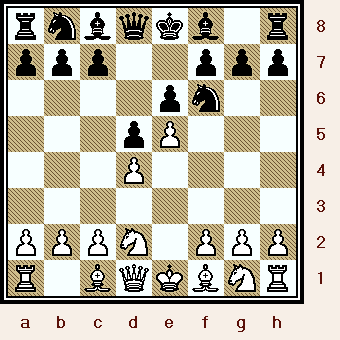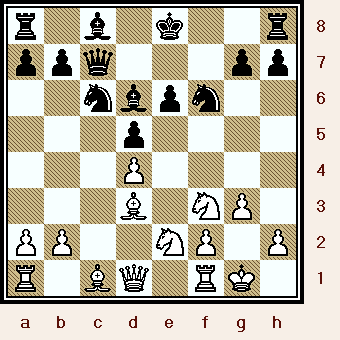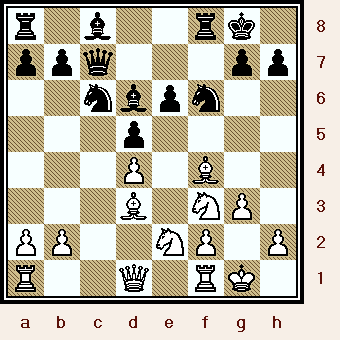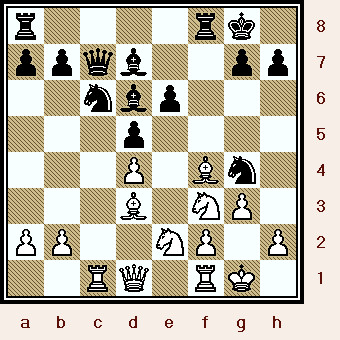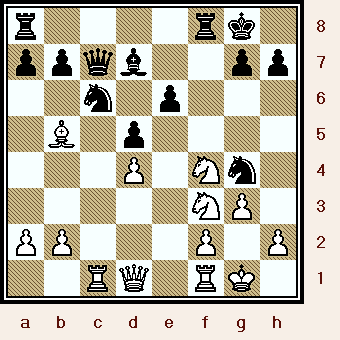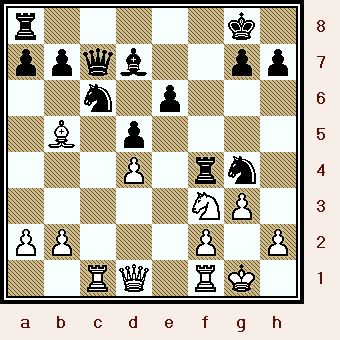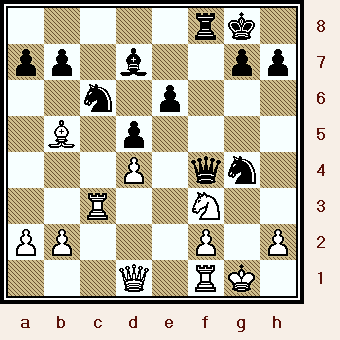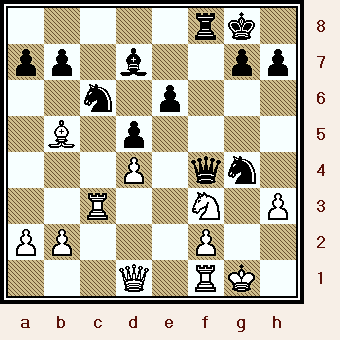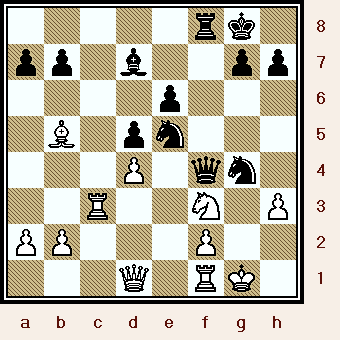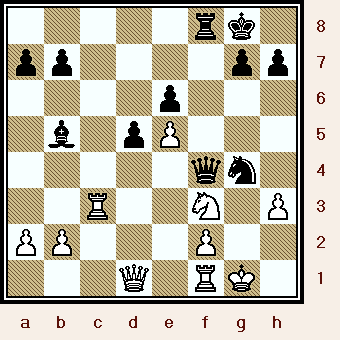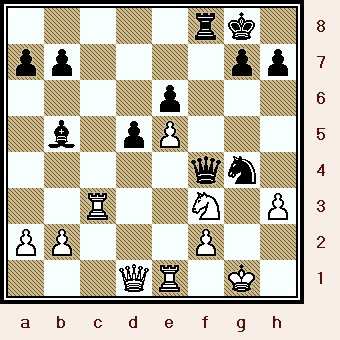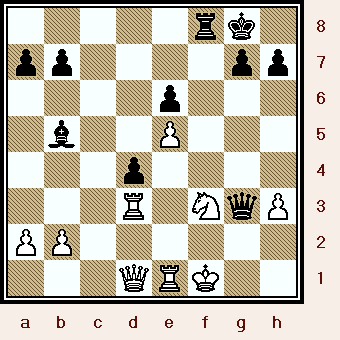All
the |
(Navigation bar
directly below.)
*******
© A.J. Goldsby, 2015.
(All rights reserved.)
****************
Click HERE
to see my
Chess Items.
****************
****************
Buy a book
from Amazon.com
(And help me out as well!)
****************
Click HERE
...
to see a list of the businesses that help to sponsor all of
my chess efforts.
|
CG - "Problem of the Day" (Sunday / May 16th, 2010.) |
Click HERE to see an explanation of the symbols that I commonly use when I annotate any chess game.
Click HERE to replay this game ... on another server.
NOTE: I started working on this game shortly after it was the POTD. (In May, 2010.) I even have taught this game to a few students. Every time I do, they invariably say, "Why don't you make game this into a web page?" To tell the truth, after my wife died (2008), I have only done a handful of web pages. But now I am starting to feel better and I have decided that I want to get back to doing one of the things that I do best. This was a great game of chess - and fully deserves to have its own web page.
So after many delays, the web page is finally here. It WAS an extremely interesting game ... the analysis (and discussion) of this game was quite spirited.
I THINK, (but I cannot verify this for sure - I believe that I read this somewhere); that the idea of play an early ...f7-f6!?; belongs to Victor Kortschnoi. (His last name is commonly spelled "Korchnoi" ... at least it is in most western countries.) If you know of a book (or source) where I could readily verify this theory, then please send me an e-mail. Thanks!
************************************************************
Second note: I do not - in any way - believe this game to be a forgery. (But as far as I can tell, it is NOT in the CB database of games!) However, I was unable to verify the source. (The Informant!? I do not have all of my old copies anymore, when I moved in 2007, a whole box full of Informants was misplaced/lost/possibly thrown in the trash. I AM very old-fashioned. When possible, I prefer to verify a game right from a printed chess book - sitting right there in front of me.) I do have a feeling that the ratings posted here could be inaccurate, but I am NOT certain of this! However, this has proved nearly impossible to track down ... for a variety of reasons. The first player in this game has passed away, and FIDE apparently has already deleted all of his information from their ratings database - to include his scorecard and ratings' history. There were (also) other questions that I had concerning this game ... exactly where was this game played? Exactly what event? Etc.
However, as I have already noted, I have been unable to track down and verify everything that I wanted to discover about the game. And - as I stated before - I don't believe this game to be a fake - my main concern was with the ratings of the two participants in this struggle. So ... I go ahead and present it as is. Enjoy!
Maxim Sorokin
(2599) - Mikhail Ulibin
(2583)
|
|
|
[A.J. Goldsby I]
A really great game of chess,
once Black takes charge and begins to sacrifice, he never backs away from the job at hand, and is definitely
up to finishing the task.
The Soviet/Russian school of chess has
always taught the value of the initiative.
(I.e., once you take control of events, you never let go of the reins.) They
also teach - that by dominating the action - you can also force your opponent
to make errors ... mistakes of the type and the kind that he/she might not
otherwise make. This contest is also a perfect illustration of the real power
of the concept of maintaining the initiative in chess.
1.e4 e6;
2.d4 d5; 3.Nd2, (Avoids the pin.)
The Tarrasch System.
Instead - if White had played
3.Nc3, this could lead to the Classical lines (of the French) or the Winawer System ...
(3.Nc3, Bb4; 4.e5, c5; 4.a3, BxN/c3+; 5.bxc3); which was really championed
by the legendary A. Nimzovich. [more]
[ Or 3.e5, (The Advance System). ]
3...Nf6;
4.e5, {See
the diagram below.}
The main line.
[The Black Knight is forced to move ... with a loss of tempo. However, (IMO); White is not really {IDEALLY} set up to exploit the closed center that now results, mainly because his Queen's Knight (on d2) blocks in his Queen's Bishop.]
|
|
rnbqkb1r/ppp2ppp/4pn2/3pP3/3P4/8/PPPN1PPP/R1BQKBNR b KQkq - 0 4
White might be sitting here thinking something like: "I really do not want to advance my e-pawn, I don't think that a closed center will give me the best advantage or is the correct way to play this particular position." And all of this could very well be true ... ... ...
Openings being what they are ... you don't always have all of your best options or cannot easily reach an ideal position ... at least, not without bad play by your opponent. In that case, then this pawn advance, (e4-e5); might be the only real way for White to secure a nominal advantage.
For more on the opening, especially the particular variation that was played in this game, (3.Nd2, Nf6; 4.e5); please see MCO-14, page # 230. (Columns # 61 through column # 66, and also please consult all the notes that pertain to those columns as well.)
[ The main alternative here would be: 4.Bd3!?, "+/=" (space); with a good game for White. ]
Both sides continue with their
main tasks of controlling the center and developing their pieces. (Black's ...f7-f6; is nearly required,
Black cannot get a decent position out of the opening if White is allowed to maintain a strong, central wedge
of pawns in the middle of the board.)
4...Nfd7;
5.c3 c5; 6.Bd3 Nc6; 7.Ne2 cxd4; 8.cxd4
f6!; 9.exf6 Nxf6; 10.Nf3 Bd6; 11.0-0
Qc7;
By a slightly different move order, (than what most books usually give);
we have arrived at one of the main lines here - which is considered playable
for both White and Black.
12.g3!?,
(hmmm) {See
the diagram below.}
This is a strange move for a master to make. (White voluntarily weakens
the light squares around his own King. The main line is 12.Bg5, see the note
just below here.) I think that the idea was trying to fortify the dark squares ...
and attempt a favorable trade of some of the minor pieces.
|
|
r1b1k2r/ppq3pp/2nbpn2/3p4/3P4/3B1NP1/PP2NP1P/R1BQ1RK1 b kq - 0 12
I think that White saw much of what was going to happen ... however, he simply failed to foresee his opponent's extremely vigorous continuation.
[
Instead, White would normally play: 12.Bg5 0-0;
13.Bh4 e5;
This gets rid of Black's weak (backward)
Pawn on e6, but leaves Black with a permanently isolated QP.
(Another idea is: 13...Nh5!?; '~' with interesting play. ).
14.dxe5 Nxe5; The end of the column.
15.Nxe5 Bxe5;
16.Bg3 Bxg3; 17.Nxg3 Qb6; 18.Qd2 Bd7;
19.h3 Rad8; 20.Rfe1, "+/="
White is slightly better here.
G. Shahade - Sarkar; New York / 2002.
(Replay
this game.)
[ See MCO-15, page # 230,
column # 61, and also note (g.). ] ]
12...0-0;
13.Bf4, "+/="
{See the
diagram below.}
(White is at least just a little bit better here - Fritz 12.)
I think that this was White's chief objective - the first player trades off Black's good Bishop ... Black is left with a possibly bad endgame.
Not only this, after an exchange of
the dark-squared Bishops, it seems to me that White can more readily exploit the weakened squares around
e5 ... especially the backward Pawn on the e6-square. (And if Black advances his e-Pawn, he will be left
with a weak, isolated d-Pawn.)
|
|
r1b2rk1/ppq3pp/2nbpn2/3p4/3P1B2/3B1NP1/PP2NP1P/R2Q1RK1 b - - 0 13
[ RR13.Nc3!? ]
13...Bd7;
14.Rc1 Ng4!?; {See
the diagram below.}
Black is trying to generate play.
|
|
r4rk1/ppqb2pp/2nbp3/3p4/3P1Bn1/3B1NP1/PP2NP1P/2RQ1RK1 w - - 0 15
This is the critical position, now with simple play, (say 15.Qd2, "+/="); White will retain a healthy advantage.
I searched the ChessBase database for this position, and I actually found over 20 games in this line! I even found several games where White won. In a contest between two prominent GM's, (Lev Psakhis and Mikhail Gurevich); the players played a few more moves and then agreed to a draw.
[
L. Psakhis - M. Gurevich / The 54th National Championships / Minsk, U.S.S.R. / 1987. ]
To replay the game, (that I just mentioned in this paragraph - just above); please see the following
web page:
http://www.chessgames.com/perl/chessgame?gid=1115165.
[
The machine prefers: RR 14...Bxf4;
15.Nxf4, "+/=" 15...Qb6;
but White still retains an edge.
**************************************************************
Or 14...Rac8!?; 15.Re1,
"+/="
and White is still (clearly) just a little better here.
]
15.Bb5!?,
(Maybe, probably - '?!')
This move looks logical, (White is undermining Black's control of the critical e5-square); but
has to be branded as being less-than-best here.
[ The best move for White was: >/= 15.Qd2, '±' (the program) Fritz 12. ]
15...Bxf4!;
16.Nxf4[], {See
the diagram below.}
This was forced for White. (Taking with the g-pawn was simply not a viable option for White.)
|
|
r4rk1/ppqb2pp/2n1p3/1B1p4/3P1Nn1/5NP1/PP3P1P/2RQ1RK1 b - - 0 16
[
Instead, after the continuation:
</= 16.gxf4?! Qb6;
17.Bxc6 Bxc6; 18.Qd2 Rf6; 19.h3 Nh6;
20.Ne5 Nf7; 21.Kh2 Bb5;
"=/+"
Black is solidly (a little) better. ]
16...Rxf4!;
(Maybe - '!!') {See
the diagram below.}
(Outstanding!!!)
Black sacks the exchange ... in return, he gets a Knight, a Pawn ... and a powerful attack.
|
|
r5k1/ppqb2pp/2n1p3/1B1p4/3P1rn1/5NP1/PP3P1P/2RQ1RK1 w - - 0 17
This is an excellent idea. And while the box may (or may not) smile on this idea, I think at the human level, this sacrifice is correct and had every chance of succeeding in over-the-board play.
17.gxf4
Qxf4; 18.Rc3 Rf8; {See
the diagram below.}
A second critical position has arisen, nearly all of Black's pieces are placed
on menacing positions.
|
|
5rk1/pp1b2pp/2n1p3/1B1p4/3P1qn1/2R2N2/PP3P1P/3Q1RK1 w - - 0 19
***************************************************************************************************************************************************************
Normally in such positions, you should
exchange pieces ... to try and sap the energy out of your opponent's attack.
19.h3?!,
(Indecisive and incorrect.) {See
the diagram below.}
This further weakens White's position
and is also a loss of tempo as well.
(The move, >/= 19.BxN/c6[], was an improvement over the game and
was required play for White.)
|
|
5rk1/pp1b2pp/2n1p3/1B1p4/3P1qn1/2R2N1P/PP3P2/3Q1RK1 b - - 0 19
Once more, we have reached a point where Black has to make some hard choices. In a nutshell, does he retreat, or continue his attack?
[ >/= 19.Bxc6T ('!') 19...Bxc6; 20.Qd2, "+/=" ]
Thanks to White's last move - which was clearly an error - the game has become a chess problem, with "Black to play."
It would be fun to play through this
game with a friend ...
and then set this position up, and see if they can guess the correct move here for Black.
19...Nce5!!;
{See the
diagram below.}
This is a BRILLIANT shot by Black!!!
|
|
5rk1/pp1b2pp/4p3/1B1pn3/3P1qn1/2R2N1P/PP3P2/3Q1RK1 w - - 0 20
It is all based on the idea that if Black can somehow decoy the WN (on f3), then the result is an immediate mate of the White King.
20.dxe5[],
("Box.")
This looked to be forced.
[ </= 20.Bxd7?? Nxf3+; 21.Qxf3 Qh2#. ]
20...Bxb5;
{See the
diagram below.}
Note how Black has gotten all of his pieces pointed directly at the White
King.
|
|
5rk1/pp4pp/4p3/1b1pP3/5qn1/2R2N1P/PP3P2/3Q1RK1 w - - 0 21
Almost needless to say, the first player is in a precarious position ... and this is exactly the kind of situation where a player is likely to make a mistake ... usually because one side has severely under-estimated the problems that now face that player.
************************************************************************************************************************************************************
Despite a couple of moves ...
that were clearly inaccurate ... White still might have a chance to save his game.
21.Re1?,
(Maybe - '??') {See
the diagram below.}
This seemingly forced {looking} reply
actually throws away any chance White had at defending his game.
(21.Qd4, or 21.Qc1, were both better
than the move - that was actually played, here - in this game.)
|
|
5rk1/pp4pp/4p3/1b1pP3/5qn1/2R2N1P/PP3P2/3QR1K1 b - - 0 21
[
Instead, after the following moves:
>/=
21.Qd4T Bxf1; 22.Qxf4 Rxf4;
23.Rc8+ Kf7; 24.Ng5+ Kg6; 25.Nxe6 Re4;
26.hxg4 Be2; "=/+"
Black is clearly (at least) a little better here, however, no forced
win is yet in sight.
I never found a completely forced win for Black, however, others have explored this position a lot more
deeply than I have. (See the kibitzes
on the "Chess Games" wp for this game ...
for more analysis of the lines that arise after
>/= 21.Qd4[], which was White's best defense in this
hard fought game of chess.) ]
Now its: "Black to move and win."
21...Nxf2!!;
(Excellent!)
Black boldly continues his assault, turning this game into an object
lesson on the power of the initiative.
[ Instead, the move of: 21...Nh2!?; was interesting, but does not seem to really lead anywhere for Black. ]
22.Kxf2[],
Now White had no choice, if 22.Qd2, ('??') then 22...Qg3#.
22...d4!;
This one move ... which attacks a White Rook, cuts off e3 as an escape square for the
WK and (also) threatens 23...Qh2# ...
will effectively end the game.
23.Rd3 Qh2+!; 24.Kf1
Qg3!; "-/+" {See
the diagram below.}
White Resigns, he cannot adequately defend the threatened White Knight
on the f3-square.
(If 25.Re2, then Black simply plays 25...BxR/d3. And if 25.Ke2,
then 25...Qg2#; will end White's misery.)
|
|
5rk1/pp4pp/4p3/1b2P3/3p4/3R1NqP/PP6/3QRK2 w - - 0 25
Although White missed the best line(s) ... (at least three different times!); this was still a wonderful combination by Black and a beautiful lesson in the relentless pursuit of the initiative! (It was also a beautiful and a very stunning combination.)
Copyright (c) A.J. Goldsby, 2010. All rights reserved.
Copyright (c) A.J. Goldsby, 2011. All rights reserved.
0 - 1
Click HERE to see the Impala Blog for/about this game.
Google M. Sorokin. Google Mikhail Ulibin. (These links were posted: Sunday; November 6th, 2011.)
( I am sad to report that I learned - after I had made this webpage - that Maxim Sorokin had passed away in 2007. [article] If you are in the mood to surf the web and learn more about these two players, then click on the links - above. Tony R. wrote me an e-mail {shortly after this game was first posted} and requested that I do a web page on M. Sorokin, but I have not found the time nor the interest to really even begin such a project (much less, finish it) ... I have literally hundreds of games that I have annotated over the years ... that I have analyzed, intending to do a web page on these games. However, for whatever reason, I have never gotten around to finishing these things.)
The analysis for this page was prepared with the excellent program, ChessBase 10.0.
The HTML was polished with several different tools and programs, (mostly FP) ... the text was checked for spelling with MS Word.
The diagrams were created with the program, Chess Captor 2.25.
Do you have a comment ... on this game? Would you like to provide me with some feedback? Then feel free to send me an e-mail.
|
Go ... or return ... to my Home Page for this site. Go (or return) ... to my "Annotated Games" (II) Page. Go
... or return ... to my "Best Games" Page. *******
Copyright (c)
LM A.J. Goldsby
I ******* This page was first generated in: (late) April, 2011. (First posted on Wednesday / April 27th, 2011.) This page last edited on: May 10, 2014 06:04 AM . |
